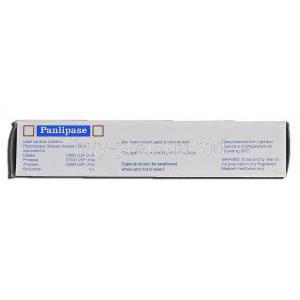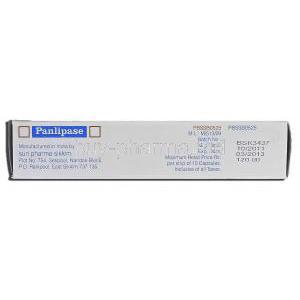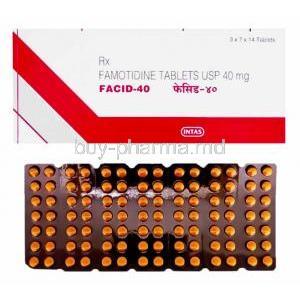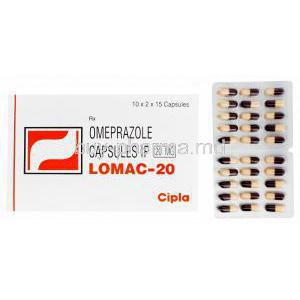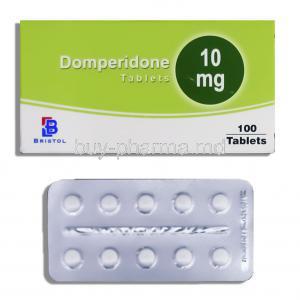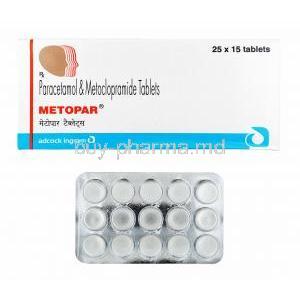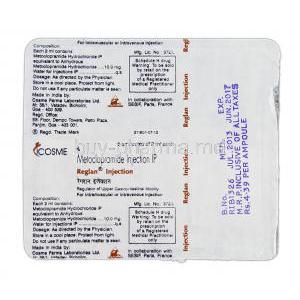Introduction
Overview of Panlipase and Pancreatin
Panlipase, containing the active ingredient Pancreatin, is a pancreatic enzyme supplement used to assist digestion in patients with pancreatic enzyme deficiency. Pancreatin is a mixture of essential digestive enzymes—lipase, amylase, and protease—that replicate the natural secretions of the pancreas. These enzymes catalyze the breakdown of fats, carbohydrates, and proteins into simpler absorbable forms, restoring normal digestive function in patients with impaired pancreatic activity.
Historical Background and Development of Pancreatic Enzyme Replacement Therapy (PERT)
The therapeutic use of pancreatic extracts dates back to the late 19th century, when physicians began using desiccated animal pancreas to treat steatorrhea and malnutrition. With advancements in biotechnology, standardized enzyme formulations such as Panlipase emerged, ensuring reliable enzyme potency and activity. Pancreatic Enzyme Replacement Therapy (PERT) has since become a cornerstone treatment for chronic pancreatitis, cystic fibrosis, and other malabsorptive disorders.
Role of Panlipase in Digestive Enzyme Supplementation
Panlipase replenishes missing pancreatic enzymes, facilitating efficient digestion and absorption of nutrients. By mimicking natural pancreatic secretions, it prevents malabsorption-related symptoms like diarrhea, abdominal distension, and fatty stools.
Importance of Enzyme Therapy in Gastrointestinal Disorders
In conditions where pancreatic output is diminished, enzyme therapy helps restore gastrointestinal equilibrium, preventing nutritional deficiencies and improving patient well-being. It is vital in maintaining adequate nutrient assimilation in chronic digestive diseases. ---
Composition and Formulation
Active Ingredients: Pancreatin (Lipase, Amylase, Protease)
Each Panlipase unit contains a balanced combination of lipase (for fat hydrolysis), amylase (for carbohydrate digestion), and protease (for protein breakdown). These enzymes collectively replicate normal digestive processes.
Enzyme Activity Units and Potency Comparison
Enzyme potency is expressed in international units (IU), allowing for accurate dosing. Panlipase maintains high enzymatic activity comparable to leading PERT formulations, ensuring optimal digestive efficacy.
Available Dosage Forms
- Enteric-coated capsules and tablets - Microgranules or delayed-release forms - Pediatric-friendly powder formulations for easy ingestion
Excipients and Stabilizing Agents
Panlipase incorporates stabilizers that preserve enzyme activity against gastric acid degradation. These include cellulose derivatives and buffering excipients that maintain enzyme integrity.
pH Stability and Enteric Coating Mechanism
The enteric coating protects enzymes from gastric acid destruction and releases them in the duodenum, where pH levels support optimal enzymatic activity. ---
Mechanism of Action: How Panlipase Works
Role of Pancreatic Enzymes in Digestion
- **Lipase** hydrolyzes dietary fats into fatty acids and glycerol. - **Amylase** converts complex carbohydrates into simple sugars. - **Protease** digests proteins into peptides and amino acids.
Replacement of Deficient Endogenous Pancreatic Enzymes
Panlipase compensates for impaired pancreatic function, ensuring digestive continuity and nutrient utilization in patients with exocrine insufficiency.
Process of Enzyme Activation in the Duodenum
Upon release into the small intestine, enzymes are activated by alkaline conditions, initiating the breakdown of ingested nutrients.
Absorption and Excretion Profile
Panlipase enzymes act locally within the gastrointestinal tract without systemic absorption. Metabolized breakdown products are excreted via feces.
Pharmacodynamic and Pharmacokinetic Considerations
The therapeutic effect depends on pH, enzyme concentration, and timing of administration with meals. ---
Therapeutic Uses
4.1. Primary Uses
- **Pancreatic Exocrine Insufficiency (PEI):** Restores digestive capacity. - **Chronic Pancreatitis:** Reduces malnutrition and steatorrhea. - **Cystic Fibrosis:** Prevents nutrient loss due to enzyme deficiency. - **Post-Pancreatectomy or Pancreatic Cancer:** Compensates for reduced enzyme secretion.
4.2. Supportive and Adjunctive Uses
- Post-gastrointestinal surgery to enhance recovery. - Management of secondary malabsorption in Crohn’s or celiac disease. - Functional dyspepsia and enzyme-deficiency-related indigestion.
4.3. Off-Label Uses
- Digestive support in irritable bowel syndrome (IBS). - Nutritional therapy for elderly patients with decreased enzyme output. - Appetite stimulation and nutrient absorption enhancement. ---
Dosage and Administration
Standard Dosage Range
Typical dosing is based on lipase activity, often ranging from 25,000–80,000 units with each meal.
Individualized Dosing
Dose titration is guided by the patient’s dietary fat content and clinical response.
Timing of Administration
Enzymes should be taken during or immediately after meals and snacks for maximum effect.
Swallowing Guidance
Enteric-coated tablets must be swallowed whole. Crushing may inactivate enzymes and irritate the oral mucosa.
Dose Adjustment in Special Populations
Lower starting doses are advised for pediatric and geriatric patients, with gradual titration based on tolerance.
Missed Dose and Overdose Protocols
If a dose is missed, it should be taken with the next meal. Overdose may cause hyperuricemia or gastrointestinal discomfort. ---
Side Effects
6.1. Common Side Effects
- Abdominal bloating - Flatulence or diarrhea - Mild nausea and vomiting
6.2. Less Common or Serious Side Effects
- Allergic skin reactions or swelling - Increased uric acid levels - Fibrosing colonopathy (rare, in cystic fibrosis) - Oral irritation from improper use ---
Warnings and Important Precautions
- Do not exceed recommended enzyme units per day. - Chronic high-dose therapy may cause intestinal narrowing. - Patients allergic to porcine proteins should exercise caution. - Regular monitoring of uric acid and nutritional markers is advised. - Adequate hydration and balanced dietary fat are essential for therapy success. ---
Contraindications
- Hypersensitivity to pancreatin or porcine derivatives - Acute pancreatitis or its exacerbations - Known intestinal obstruction or strictures - Severe hepatic or biliary dysfunction ---
Drug Interactions
- **Antacids:** Calcium or magnesium hydroxide may reduce enzyme efficacy. - **Acarbose/Miglitol:** Can diminish carbohydrate digestion efficiency. - **Iron Supplements:** Reduced absorption due to pH alteration. - **PPIs/H2 Blockers:** May affect intestinal release of enzymes. - **Alcohol:** Interferes with enzyme activity and digestion. ---
Careful Administration and Monitoring
- Regular evaluation of fecal fat to assess enzyme adequacy. - Monitor serum uric acid and nutritional status during prolonged use. - Adjust dosing in cystic fibrosis or low-fat diet regimens. - Clinical reassessment is essential for long-term therapy management. ---
11. Administration in Special Populations
11.1. Use in Elderly Patients
As individuals age, pancreatic exocrine function naturally declines, leading to reduced enzyme secretion and impaired nutrient absorption. Panlipase plays a crucial role in restoring digestive efficiency in elderly patients, especially those experiencing steatorrhea or chronic indigestion. Dosage should be carefully titrated according to the individual’s digestive capacity and dietary fat intake. Lower starting doses are often advised, with gradual escalation to minimize gastrointestinal discomfort. Elderly patients are frequently subject to **polypharmacy**, increasing the likelihood of drug interactions. Monitoring for adverse reactions—especially when taking acid suppressants, antacids, or diuretics—is recommended. Regular clinical evaluation ensures that therapy remains effective and safe. Additionally, maintaining **adequate hydration** and balanced nutrition is essential, as dehydration and malnutrition can exacerbate digestive issues. Continuous monitoring of vitamin levels and body weight assists in preventing deficiencies during prolonged enzyme therapy. ---
11.2. Use in Pregnant and Nursing Women
Data from animal studies and limited human research suggest that Panlipase (Pancreatin) does not produce teratogenic effects when used within therapeutic limits. However, comprehensive clinical evidence in pregnant women remains insufficient, necessitating caution. During pregnancy, enzyme supplementation should only be initiated if the potential benefits outweigh possible risks. The decision must be individualized, with obstetric consultation to ensure maternal and fetal safety. For **nursing mothers**, Panlipase is considered low-risk as it acts locally in the gastrointestinal tract and is not systemically absorbed. Nevertheless, infant monitoring for digestive changes or allergic manifestations is prudent. In cases of pregnancy-related digestive disturbances or chronic pancreatitis, enzyme therapy may aid in maintaining adequate nutrient absorption, supporting both maternal and fetal health. **Nutritional supplementation** with vitamins A, D, E, and K may be required, as malabsorption can limit fat-soluble vitamin uptake. ---
11.3. Use in Children
Panlipase is frequently indicated for pediatric patients suffering from **cystic fibrosis** or congenital pancreatic enzyme deficiency. These conditions impair digestion from an early age, leading to malnutrition and growth delays. Dosage in children should be based on body weight, typically measured in lipase units per kilogram per meal. Pediatric formulations—such as enteric-coated microspheres—are preferred for ease of swallowing and accurate dosing. Continuous **safety monitoring** is essential, particularly to prevent excessive dosing that may lead to intestinal strictures. Parents and caregivers should be instructed never to crush or chew enteric-coated tablets, as doing so can cause oral mucosal irritation and deactivate the enzyme before reaching the intestine. ---
12. Overdosage
Excessive intake of Panlipase may lead to biochemical and gastrointestinal disturbances. **Symptoms may include:** * Elevated serum or urinary uric acid levels (**hyperuricemia** or **hyperuricosuria**) * Abdominal pain or cramping * Nausea, vomiting, or intestinal irritation **Management and Supportive Care:** * Immediate discontinuation of the medication is recommended. * Ensure proper **hydration** to aid renal clearance of uric acid. * Monitor electrolyte balance and renal function. * Symptomatic relief through antiemetics or antacids may be required. * In severe cases, contact a **poison control center** or seek emergency medical attention for further evaluation and intervention. ---
13. Storage and Handling Precautions
Proper storage is essential to maintain enzyme potency and stability. * **Storage Temperature:** Keep below 25°C (77°F) in a cool, dry environment. * **Humidity and Light Protection:** Store in tightly sealed containers away from moisture and direct sunlight. * **Handling Guidance:** Avoid crushing or opening enteric-coated capsules, as exposure to gastric acid can deactivate the enzymes. * **Disposal:** Expired or unused medication should be safely discarded according to local pharmaceutical waste guidelines. * **Travel Precautions:** Keep medication in its original packaging to preserve labeling and protect against humidity and heat during transport. ---
14. Clinical Efficacy and Research Insights
Extensive clinical research supports the effectiveness of Panlipase in managing **pancreatic exocrine insufficiency (PEI)**. Clinical trials have demonstrated significant improvement in fat absorption, stool consistency, and overall nutritional parameters. Comparative analyses reveal that Panlipase provides enzyme activity comparable to or exceeding that of other pancreatin-based formulations, with superior tolerability due to its enteric coating. Evidence highlights that enzyme therapy enhances **nutrient assimilation**, leading to measurable weight gain, improved fat-soluble vitamin levels, and reduced gastrointestinal distress. Furthermore, **patient-reported outcomes** emphasize increased appetite, better digestion, and enhanced quality of life, particularly in chronic pancreatitis and cystic fibrosis patients. Long-term adherence to therapy correlates with reduced malnutrition-related complications and hospitalizations. ---
15. Patient Education and Lifestyle Guidance
Proper education on enzyme therapy ensures optimal treatment outcomes. **Dietary Recommendations:** * Consume Panlipase with every meal or snack containing fat. * Maintain a well-balanced diet with controlled fat intake. * Avoid alcohol and excessive fried or spicy foods that can impair digestion. **Meal Timing and Fat Composition:** * Take enzymes during or immediately after meals for maximum absorption. * Consistency in dosing improves nutrient uptake and symptom control. **Adherence Importance:** * Skipping doses can lead to digestive discomfort and nutritional deficiencies. * Regular monitoring of weight, stool consistency, and vitamin levels is advised. **Signs of Improper Dosing:** * Persistent bloating, fatty stools, or diarrhea may indicate underdosing. * Abdominal pain or elevated uric acid levels could signal overdosing. A structured routine, combined with dietary discipline and physician supervision, ensures that Panlipase delivers sustained digestive and metabolic benefits for patients managing pancreatic enzyme insufficiency.


